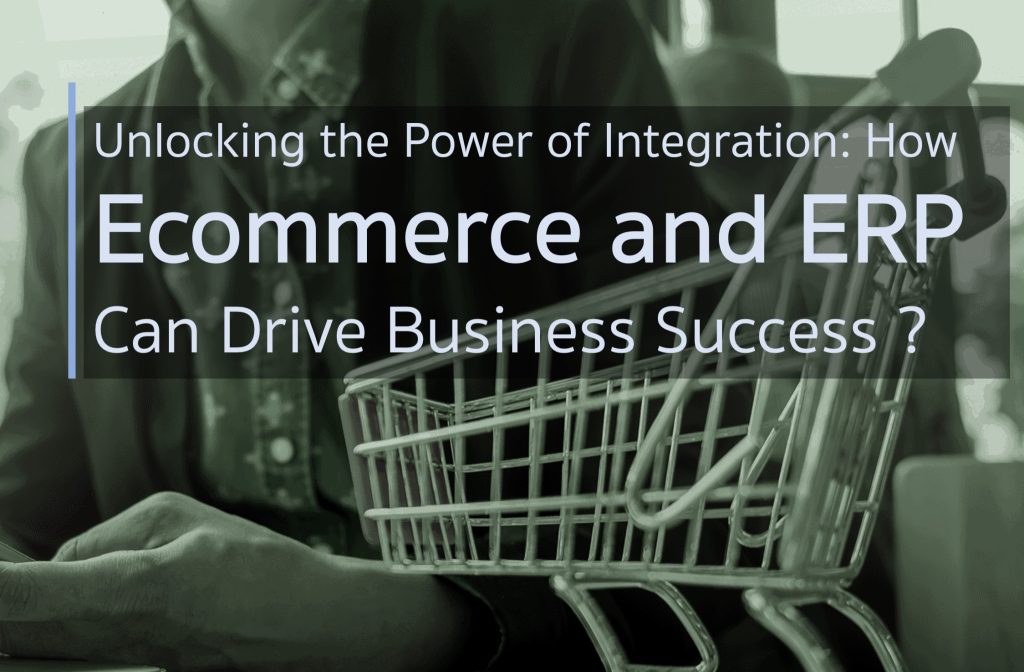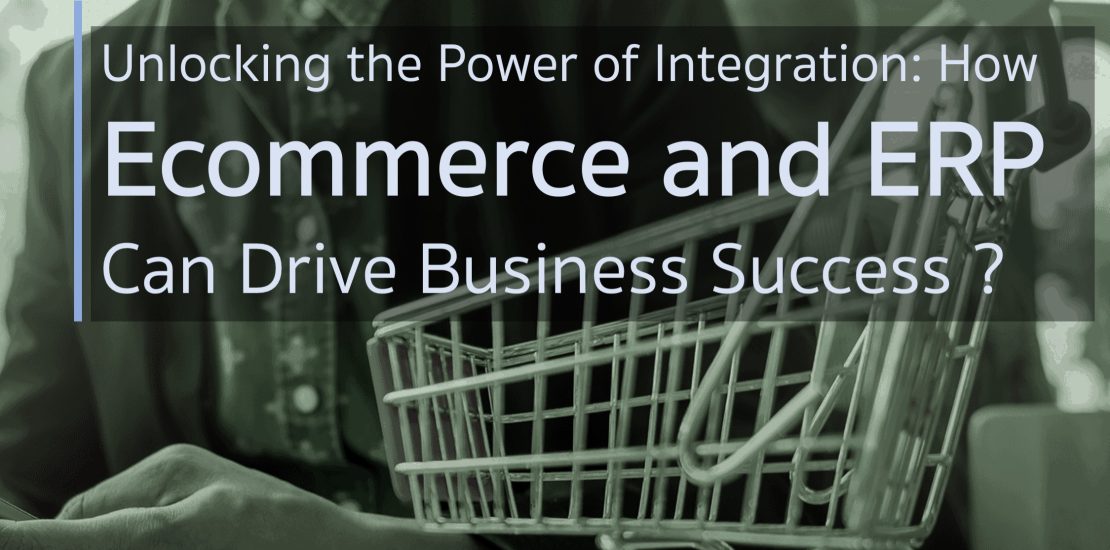Unlocking the Power of Integration: How Ecommerce and ERP Can Drive Business Success ?

Are you looking to maximize your business’s potential and drive success in the ecommerce space?
The key lies in unlocking the power of integration between your ecommerce platform and your ERP system. In this article, we will explore how the integration of ecommerce and ERP can revolutionize your business operations and propel growth.
Today’s competitive business landscape demands efficient and streamlined workflows that enable seamless order management, inventory tracking, and financial reporting. By integrating your ecommerce platform with your ERP system, you can eliminate bottlenecks, reduce manual data entry, and gain real-time visibility into your business processes. This integration empowers you to make data-driven decisions, optimize inventory levels, and deliver exceptional customer experiences.
Furthermore, the synergy between ecommerce and ERP allows you to automate tasks such as order fulfillment, shipping, and customer support, saving time and resources while ensuring accuracy and consistency. In the age of digital transformation, businesses that harness the power of integration are poised for success in the ecommerce realm.
Unlock the full potential of your business by embracing the integration of ecommerce and ERP. Let’s explore how this powerful union can drive your business forward and set you apart from the competition.
The benefits of integrating ecommerce and ERP systems
Integrating your ecommerce and ERP systems offers numerous benefits that can significantly impact your business’s success. Let’s delve into some of the key advantages of this integration.
- Streamlined workflows and improved efficiency
One of the primary benefits of integrating ecommerce and ERP systems is the ability to streamline your workflows and improve efficiency. Without integration, your teams may have to manually transfer data between systems, leading to errors, delays, and inconsistencies. However, when your ecommerce platform and ERP system are seamlessly connected, data flows smoothly, eliminating the need for manual intervention.
With integrated systems, orders placed on your ecommerce platform are automatically transferred to your ERP system, triggering order fulfillment processes, inventory updates, and financial transactions. This automation saves time, reduces human error, and enables your teams to focus on more strategic tasks, ultimately improving overall efficiency.
- Real-time visibility and accurate reporting
Another significant advantage of integrating ecommerce and ERP systems is the ability to gain real-time visibility into your business processes and access accurate reporting. Traditional manual processes often result in delays in data synchronization, making it difficult to have an accurate view of your inventory levels, sales performance, and financial health.
By integrating your systems, you can have real-time access to crucial data, enabling you to make informed decisions promptly. You can monitor inventory levels, track sales performance, and generate accurate financial reports with ease. This real-time visibility empowers you to identify trends, spot opportunities, and address any potential issues swiftly, giving you a competitive edge in the ecommerce landscape.
- Enhanced customer experience
Integration of ecommerce and ERP systems can have a direct impact on the customer experience you provide. When your systems are integrated, you can provide accurate and up-to-date information to your customers, such as order status, shipping updates, and product availability. This transparency builds trust and improves customer satisfaction, leading to repeat purchases and positive word-of-mouth.
Moreover, integrating your systems enables you to automate order processing, fulfillment, and shipping, ensuring faster and more reliable delivery of products to your customers. This streamlined process minimizes errors, reduces delays, and enhances the overall customer experience. By meeting and exceeding customer expectations, you can build brand loyalty and drive customer retention.
Common challenges in integrating ecommerce and ERP systems
While the benefits of integrating ecommerce and ERP systems are evident, it’s essential to be aware of the common challenges that may arise during the integration process. Understanding these challenges can help you prepare and overcome them effectively.
- Data compatibility and mapping
One of the primary challenges in integrating ecommerce and ERP systems is ensuring data compatibility and mapping. The two systems may use different data structures, fields, and formats, making it difficult to transfer data seamlessly. Mapping the data fields between the systems is crucial to ensure accurate and meaningful data transfer.
To address this challenge, it is essential to thoroughly analyze the data requirements of both systems and identify any discrepancies. This analysis will help you determine the necessary data transformations and create appropriate mapping rules. Additionally, leveraging integration tools or working with experienced integration partners can simplify the data mapping process and ensure a smooth integration.
- System integration complexity
Integrating ecommerce and ERP systems can be a complex process, especially if your systems have different architectures, technologies, or versions. The level of complexity increases when dealing with legacy systems that may not have built-in integration capabilities.
To overcome this challenge, it is crucial to carefully evaluate the integration capabilities of your ecommerce and ERP platforms. Look for platforms that offer robust APIs (Application Programming Interfaces) and integration options. These integration capabilities will facilitate the seamless exchange of data between your systems and reduce the overall complexity of the integration process.
- Change management and training
Integrating ecommerce and ERP systems often requires changes in business processes and workflows. This change may disrupt existing operations and require your teams to adapt to new ways of working. Change management and training become critical to ensure a smooth transition and successful adoption of the integrated systems.
It is essential to communicate the benefits of integration to your teams and involve them in the integration planning process. Provide comprehensive training sessions to familiarize your teams with the new processes and workflows. Additionally, designate key personnel who can act as integration champions and provide ongoing support to address any concerns or challenges during the transition period.
Best practices for successful integration
To ensure a successful integration of your ecommerce and ERP systems, it is important to follow some best practices. These practices will help you navigate the integration process smoothly and maximize the benefits of integration.
- Define clear integration goals and objectives
Before embarking on the integration journey, it is crucial to define clear integration goals and objectives. What specific outcomes are you looking to achieve through integration? Do you want to streamline order processing, improve inventory management, or enhance reporting capabilities? Defining these goals will guide your integration strategy and help you prioritize integration efforts.
By clearly defining your integration goals, you can also establish key performance indicators (KPIs) to measure the success of the integration project. These KPIs will enable you to track progress, identify areas for improvement, and ensure that the integration aligns with your overall business objectives.
- Conduct a thorough system analysis and evaluation
Before integrating your ecommerce and ERP systems, it is essential to conduct a thorough analysis of your existing systems and evaluate their compatibility. Identify any gaps or limitations in your systems that may impact the integration process. This analysis will help you determine the level of effort required for integration and identify any potential roadblocks.
During the evaluation process, consider factors such as system architecture, data structures, integration capabilities, scalability, and security. Assess whether your systems can handle the expected data volume, support future growth, and meet compliance requirements. This evaluation will enable you to make informed decisions about the integration approach and select the right integration tools and platforms.
- Collaborate with experienced integration partners
Integrating ecommerce and ERP systems can be a complex process, and partnering with experienced integration experts can significantly simplify the implementation. Look for integration partners who have a proven track record of successfully integrating similar systems. These partners can provide valuable insights, guidance, and technical expertise to ensure a smooth integration.
When selecting an integration partner, consider their industry experience, knowledge of the ecommerce and ERP platforms, and their ability to understand your unique business requirements. Collaborating with the right integration partner can help you navigate challenges, mitigate risks, and accelerate the integration process, saving you time and resources.
Choosing the right ecommerce and ERP platforms for integration
Selecting the right ecommerce and ERP platforms for integration is crucial to the success of your integration project. The compatibility, scalability, and integration capabilities of these platforms will determine the ease and effectiveness of the integration process. Here are some factors to consider when choosing the platforms for integration.
- Integration capabilities
Ensure that both your ecommerce and ERP platforms offer robust integration capabilities. Look for platforms that provide well-documented APIs, pre-built connectors, or integration frameworks that simplify the integration process. These integration capabilities will enable seamless data exchange between your systems and reduce the need for custom development.
Additionally, consider the availability of integration tools or middleware that can facilitate the integration process. These tools can provide pre-built connectors, data transformation capabilities, and monitoring and error handling functionalities, making integration easier and more efficient.
- Scalability and flexibility
Consider the scalability and flexibility of your chosen platforms. As your business grows, your systems should be able to handle increased data volumes, user traffic, and transactional demands. Ensure that both your ecommerce and ERP platforms can scale seamlessly to accommodate future growth without compromising performance or stability.
Flexibility is also crucial, as it allows you to adapt your systems to changing business requirements. Look for platforms that offer customization options, extensibility through APIs, and the ability to integrate with third-party applications. This flexibility will ensure that your integrated systems can evolve and meet your evolving business needs.
- Vendor support and community
Evaluate the vendor support and community surrounding your chosen platforms. A responsive and knowledgeable vendor support team can provide timely assistance and help you resolve any integration issues or challenges. Look for platforms with a strong support reputation and a dedicated support team.
Additionally, consider the presence of an active user community or developer community for your chosen platforms. These communities can provide valuable resources, documentation, forums, and best practices related to integration. The availability of a vibrant community can be a valuable asset when seeking guidance or troubleshooting integration-related queries.
Choosing the right ecommerce and ERP platforms for integration requires careful consideration of your business requirements, integration capabilities, scalability, flexibility, vendor support, and community presence. By selecting platforms that align with your needs and integration goals, you can set a solid foundation for a successful integration project.
Steps to integrate ecommerce and ERP systems
The integration of ecommerce and ERP systems involves several steps that need to be carefully executed to ensure a seamless integration. Here is a general framework that can guide you through the integration process.
- Define integration requirements and scope
Start by defining your integration requirements and scope. Determine what data needs to be shared between your ecommerce platform and ERP system. Identify the integration touchpoints, such as order management, inventory management, customer data, and financial transactions. Clearly define the data flows, triggers, and actions required for the integration.
Additionally, establish the scope of your integration project. Determine whether you want a full integration that covers all aspects of your ecommerce and ERP systems or a phased integration that focuses on specific functionalities. Defining the requirements and scope upfront will help you plan and execute the integration effectively.
- Select integration tools or middleware
Choose the integration tools or middleware that will facilitate the data transfer between your ecommerce and ERP systems. These tools can provide pre-built connectors or APIs that simplify the integration process. Evaluate the available integration tools based on factors such as ease of use, compatibility with your platforms, data transformation capabilities, and error handling functionalities.
If you prefer a custom integration, consider leveraging development frameworks or programming languages that align with your existing technology stack. Ensure that your chosen integration approach aligns with your integration goals, system architecture, and technical capabilities.
- Map data fields and define transformation rules
Map the data fields between your ecommerce and ERP systems and define the necessary data transformation rules. Identify any discrepancies in data structures, formats, or fields and create appropriate mapping rules to ensure accurate data transfer. Pay special attention to data validation, data cleansing, and data synchronization requirements during the mapping process.
Consider leveraging data integration or transformation tools that can streamline the data mapping and transformation process. These tools can help automate the data transformation, reduce manual effort, and ensure data integrity during the integration.
- Develop and test integration workflows
Develop the integration workflows that will orchestrate the data transfer between your ecommerce and ERP systems. These workflows should include triggers, actions, and error handling mechanisms. Leverage your chosen integration tools or middleware to build these workflows or develop custom integration code based on your requirements.
Once the workflows are developed, thoroughly test them to ensure their accuracy and reliability. Test different integration scenarios, such as order placement, inventory updates, and data synchronization, to validate the integration workflows. Conduct end-to-end testing to simulate real-world scenarios and identify any issues or bugs that need to be addressed before going live.
- Deploy and monitor the integration
After successful testing, deploy the integration workflows and monitor their performance. Monitor the data flows, error logs, and system performance to ensure that the integration is working as expected. Establish monitoring and alerting mechanisms to promptly identify and address any integration-related issues.
Regularly review and optimize the integration workflows based on feedback from users, system performance, and evolving business requirements. Continuous monitoring and optimization will help you maintain a seamless and efficient integration between your ecommerce and ERP systems.
Case studies of successful ecommerce and ERP integration
To illustrate the real-world impact of integrating ecommerce and ERP systems, let’s explore a few case studies of businesses that have successfully implemented this integration.
Case Study 1: Company A – Streamlining order processing and inventory management
Company A, an online retailer, integrated their ecommerce platform with their ERP system to streamline order processing and inventory management. The integration enabled automatic transfer of order details from the ecommerce platform to the ERP system, triggering order fulfillment processes and inventory updates.
As a result, Company A experienced significant improvements in order processing time, reducing order fulfillment from days to hours. The integration also provided real-time visibility into inventory levels, enabling proactive inventory management and reducing stockouts. By automating order processing and inventory management, Company A could scale their operations, handle increased order volumes, and deliver exceptional customer experiences.
Case Study 2: Company B – Enhancing financial reporting and analysis
Company B, a B2B ecommerce company, integrated their ecommerce platform with their ERP system to enhance financial reporting and analysis. The integration facilitated the automatic transfer of sales data, invoice details, and payment information from the ecommerce platform to the ERP system.
With the integrated systems, Company B gained real-time visibility into their financial performance, enabling them to generate accurate financial reports and conduct in-depth analysis. The integration eliminated manual data entry and reconciliation, reducing errors and saving valuable time for their finance team. By leveraging the integrated systems, Company B could make data-driven decisions, optimize pricing strategies, and drive profitability.
Case Study 3: Company C – Improving customer experience and order fulfillment
Company C, a fashion retailer, integrated their ecommerce platform with their ERP system to improve customer experience and order fulfillment. The integration enabled seamless communication between the systems, providing accurate product availability, order status updates, and shipping information to their customers.
By automating order processing and fulfillment, Company C reduced order processing time and improved order accuracy. The integration also enabled them to offer flexible shipping options, such as click-and-collect and same-day delivery, enhancing the overall customer experience. By providing accurate and timely information to their customers, Company C saw an increase in customer satisfaction and repeat purchases.
These case studies demonstrate how integrating ecommerce.
More information about SAP Business One, please contact:
Sundae Solutions Co., Ltd.
T| +6626348899 E| sales@sundae.co.th
W| https://www.sundae.co.th/en/solutions/erp/sap-business-one/
- May 3, 2024
- Posted by: sundaeadmin
- Category: Articles-EN


